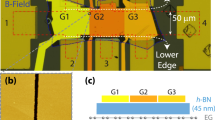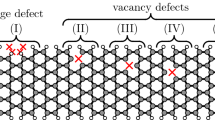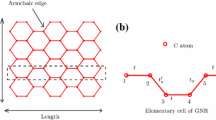Abstract
Electrostatically doped graphene p–n junctions can modulate graphene nanoribbon conductance and can be indispensable parts of nanoelectronic graphene circuits. Much research has been conducted on such devices with one rectangular top gate and one back gate with very encouraging results. Recently, graphene p–n junctions with two rectangular top gates have been proposed and their study revealed a rich behaviour that allows their use in both analogue and digital nanoelectronic circuits. Here we study graphene p–n junctions with two trapezoid top gates and a common back gate with special focus to the effect of the angle and the distance between the two top gates. Furthermore, trapezoid top gates with angles of 45° make use of the Veselago lens effect, allowing an effective control by tuning density of states and carrier density. We simulated these devises using the non-equilibrium Green’s function method combined with tight-binding Hamiltonians in the ballistic transport limit. Our results show that the conductance of these graphene p–n junctions can be successfully controlled by various combinations of different parameters that allows for realisation of carbon-based logic gates. We also present the design and simulation a universal set Boolean gates, namely NOT, NAND and NOR.

source and drain contacts as well as the substrate are usually much larger than the actual ribbon in physical devices












Similar content being viewed by others
References
Gray D, McCaughan A, Mookerji B (2009) Crystal structure of graphite graphene and silicon. Phys Solid State Appl 6:730
Castro Neto AH, Guinea F, Peres NMR, Novoselov KS, Geim AK (2009) The electronic properties of graphene. Rev Mod Phys 81:109–162
Fuchs JN, Goerbig M O (2008) Introduction to the physical properties of grapheme. Lecture Notes
Wolf EL (2014) Graphene. Oxford University Press, Oxford
Aliofkhazraei M, Nasar A, Milne WI, Ozkan CS, Mitura S, Gervasoni J L (2016) Graphene science handbook. CRC Press, Boca Raton
Uppstu A (2014) Electronic properties of graphene from tigh-binding simulations Aalto University publication series: Doctoral Dissertations 122/2014
Karafyllidis IG (2014) Current switching in graphene quantum point contacts. IEEE Trans Nanotechnol 13:820–824
Low T, Hong S, Appenzeller J, Datta S, Lundstrom MS (2009) Conductance assymetry of graphene p–n junction. IEEE Trans Electron Dev 56:1292–1299
Zhu W-H, Ding G-H (2011) Electron transport through p–n junction of zigzag nanoribbon with external transerse electric field. J Appl Phys 110:113710
Williams JR (2009) Electronic Transport in Graphene: p-n Junctions, Shot Noise, and Nanoribbons. Harvard University, Cambridge
Zhang LM, Folger MM (2008) Nonlinear screening and ballistic transport in a graphene p–n junction. Phys Rev Lett 100:116804
Chiu H-Y, Perebeinos V, Lin Y-M, Avouris Ph (2010) Controllable p-n junction formation in monolayer graphene using electrostatic substrate engineering. Nano Lett 10:4634–4639
Katsnelson MI, Novoselov KS, Geim AK (2006) Chiral tunneling and the Klein paradox in graphene. Nat Phys 2:620–625
Sajjad RN, Sutar JU, Ghosh AW (2012) Manifestation of chiral tunneling at a tilted graphene p–n junction. Phys Rev B 86:155412
Cheianov VV, Fal’ko V, Altshuler BL (2007) The focusing of electron flow and a veselago lens in graphene p–n junctions. Science 315:1252–1255
Nikiforidis I, Karafyllidis IG, Dimitrakis P (2018) Simulation and parametric analysis of graphene p–n junctions with two rectangular top gates and a single back gate. J Phys D Appl Phys 51:075303
Bhat A K, Singh V, Patil S and Deshmukh M M (2011) Dual top gated graphene transistor in the quantumHall regime. Solid State Commun 152
Liu J, Safani-Naeini S, Ban D (2014) Fabrication and measurement of graphene p–n junction with two top gates. Electron Lett 50:1724–1726
Tenace V, Calimera A, Macil E and Poncino M (2016) Graphene-PLA: a Compact and Ultra-Low Power Logic Array Architecture International Great Lakes Symposium on VLSI (GLSVLSI) 145–150
Datta S (2012) Lessons from nanoscience: a lecture note series. World Scientific Publishing Company, Singapore
Datta S (2005) Quantum transport – atom to transistor. Cambridge University Press, Cambridge
Datta S (2000) Nanoscale device modeling: the Green’s function method. Superlattices Microstruct 28:253–278
Datta S (1995) Electronic transport in mesoscopic systems. Cambridge University Press, Cambridge
Pourfath M (2014) The non-equilibrium green’s function method for nanoscale device simulation. Springer, Berlin
Hanckok Y, Uppstu A, Saloriutta A, Harju A, Puska MJ (2010) Generalized tight-binding transport model for graphene nanoribbon-based systems. Phys Rev B 81:245402
Machac P, Cichon S, Lapcak L, Fekete L (2020) Graphene prepared by chemical vapour deposition process. Graphene Technol 2:9–17
Rigosi AF, Marzano M et al (2020) Analytical determination of atypical quantized resistances in graphene p–n junctions. Phys B: Condens Matter 582:411971
Liu CI, Patel DK, Marzano M, Kruskopf M, Hill HM, Rigosi AF (2020) Quantum Hall resistance dartboards using graphene p-n junction devices with Corbino. Geometries AIP Adv 10:035205
Sancho MPL, Sancho JML (1984) Quick iterative scheme for the calculation of transfer matrices : Application to Mo (100). J Phys F Metal Phys 14:1205–1215
Moysidis S, Karafyllidis IG, Dimitrakis P (2018) Graphene Logic Gates. IEEE Trans Nanotechnol 17:852–859
Author information
Authors and Affiliations
Corresponding author
Additional information
Publisher's Note
Springer Nature remains neutral with regard to jurisdictional claims in published maps and institutional affiliations.
Rights and permissions
About this article
Cite this article
Nikiforidis, I., Karafyllidis, I.G., Dimitrakis, P. et al. Design and simulation of graphene logic gates using graphene p–n junctions as building blocks. Graphene and 2D Materials Technol 6, 35–47 (2021). https://doi.org/10.1007/s41127-021-00043-7
Received:
Revised:
Accepted:
Published:
Issue Date:
DOI: https://doi.org/10.1007/s41127-021-00043-7




